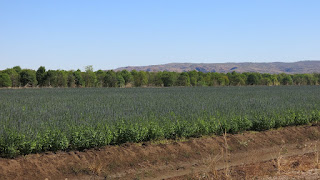What holds twenty one times the amount of water that is in Sydney Harbour? The answer we were told is Lake Argyle. This man-made reservoir was originally created 1971 by the construction of the Ord River Dam. It was opened the following year when in just one wet season it filled. In 1996, the spillway wall was raised by 6 metres, which doubled the lake’s capacity. Spectacular certainly with mountain tops showing through the water. Its main purpose is to irrigate farm land, although the local population has an excellent water supply, the envy of many parts of north Australia.
We stayed at the Lake Argyle Resort. Sounds posh but it’s only a camp site. The view across the lake from the infinity pool was lovely, but we avoided it as it was cold. Some hardy folk braved it though.
We contented ourselves with some sightseeing, taking this picture of Vin Rouge against a backdrop of the lake.
For the last few weeks, all had been going rather well. We’d helped Glynn with this electrical problems that turned out to be a failing second battery. Now I’m not really certain t hat Land Rovers talk to one another, but it does seem strange that a couple of days after Glynn departed the fault light on the fridge came on. The cause? A failing second battery! Fortunately in the small town of Kununurra we found a tyre shop that had the correct battery in stock and even fitted it for us. So once again ‘we’re all good’ as the Aussies say. Travelling tip for anyone planning on staying over at Kununurra. Avoid it. The local indigenous population decided to have a bit of a shindig and blasted out rap music from 8pm until 6.45am – nonstop. Somewhat grumpy today we set off for Wyndham (the most northern town in WA), an easy 100km away and hopefully a peaceful night.
That’s not the end of today’s lessons. We’re now talking Boab trees, or baobab as some people call them or upside down trees as others call them. We thought that these trees were natives of Africa, but it seems they are also native to northern Australia. We’ve seen a lot of the swollen trunks of these tree, many of the ages old. This one was inscribed on July 2 1854, during Augustus Gregory’s exploration of the territory.
Boab trees grow quite large, some even a lot larger than this one.
The area is now a major producer of chia (a healthy seed apparently) and over 90 percent of the world’s production of sandalwood. We discovered that sandalwood is a parasitic tree, taking its nutrients from a host tree. The wood is used in the making of incense and for religious rites. The extracted oil, known as liquid gold, it’s that valuable, is used in pharmaceuticals and of course, perfumes. Here’s chia in the foreground with sandalwood trees behind.
Enough of the scholastics. I’ll finish here in Wyndham after a G&T and one of Kim’s chicken curry dinners. And it look like it’ll be a quiet night!







No comments:
Post a Comment